Diff MITSUBISHI PAJERO 1996 2.G Owners Manual
[x] Cancel search | Manufacturer: MITSUBISHI, Model Year: 1996, Model line: PAJERO, Model: MITSUBISHI PAJERO 1996 2.GPages: 302, PDF Size: 48.23 MB
Page 1 of 302

Downloaded from www.Manualslib.com manuals search engine EB21AOD OvervietN -Instruments and controls
5 6789 101112 13 4
3
2 1 --::;tt;~.
35---tt-"'
34
33
32
31 3 0
2 8 ----...,,+/
2'1
26
25 24 23 U 0~,,~
2 1 20 19 18 17
66E 00 13
Rear . 10.!. EleCtronic 11:' Thermometer' 12:.. Inclinometer' .1:j':' Altimeier' 14":· Cloek · .15 -. Front heater/air conditioner' 16-Audio' 17 -. Accessory socket 18 -Rear differential Ipck switch' 19 -Transfer shift lever 20 _ Mechanical winch' 21 -Gearshift lever (M/T only) 22 -Cigarette lighter 23- Rear heater/air conditioner switch·~for front seat 24 -Heated seat switch' . 25 -Three mode variable shock absorber changeover switch' 26 -Rear heater/air conditioner switch· . for rear seat
27 -Selector lever (A/T only) 28 -Parki ng brake laver 29 -Overdrive control switch (A/T only) 30 -Engine rpm adjusting knob (Diesel models only) 3'1 - Rear window wiper and washer switch' 32 -Headlamp leveling switch' 33 -Rheostal (meter illuminalion control) 34 - Electric remote -controlled outside rear-view rnirrors~ 35 -Auto-speed (cruise) control lever'
Indication of applicab ility F.B2IC-A Optional equipment marke d with ",- may differ according to the country it is sold in o r the sale s classification; refer to the sal es catalogue.
Page 40 of 302
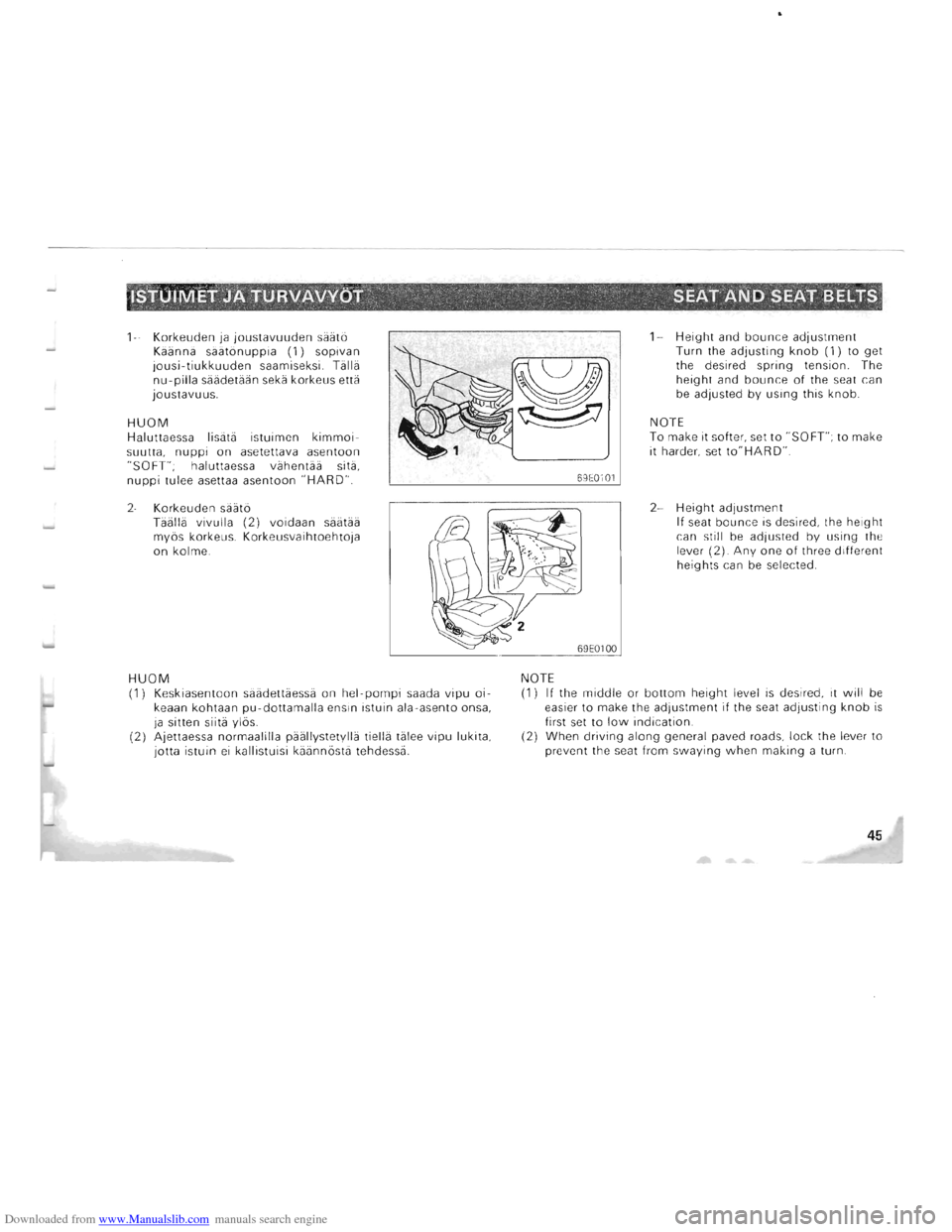
Downloaded from www.Manualslib.com manuals search engine IS'TOiMET'~'A TURVAVv6i".· " ,'. ,', '.' ' .,' ,-,' SEAT'AND SEAT BELTS' " '.
1-Korkeuden ja joustavuuden saata
Kaanna saatanuppia (1) sopivan jousi-tiukkuuden saamiseksi. Talla nu-pilla saadetaan seka korkeus etta joustavuus.
HUOM Haluttaessa lisata istuimen kimmoi
suutta, nuppi on asetettava asentoon "SOFT"; haluttaessa vahentaa sita, nuppi tulee asettaa asentoon "HARD".
2-Korkeuden saata
Taalla vivulla (2) voidaan saataa
myas korkeus. Korkeusvaihtoehtoja
on kolme.
HUOM (1) Keskiasentoon saadettaessa on hel-pompi saada vipu oikeaan kohtaan pu-dottamalla ensin istuin ala-asento onsa,
ja sitten siita ylas.
(2) Ajettaessa normaalilla paallystetylla tiella talee vipu lukita , jotta istuin ei kallistuisi kaannasta tehdessa.
69E0101
NOTE
1-Height and bounce adjustment
Turn the adjusting knob (1) to get the desired spring tension. The height and bounce of the seat can
be adjusted by using this knob_
NOTE To make it softer, set to "SOFT"; to make
it harder, set to" HAR D".
2-Height adjustment If seat bounce is desired, the height can still be adjusted by using the
lev er (2) . Anyone of three different
heights can be selected.
(1) If the middle or bottom height leve l is desired , it will be easier to make the adjustment if the seat adjusting knob is first set to low indication. (2) When driving along general paved roads, lock the lever to
prevent the seat from swaying when making a turn.
45
Page 57 of 302

Downloaded from www.Manualslib.com manuals search engine I$T.UIMET,JA TURVAVVDT , ' SEAT AND,SEAT BELTS
Paantukien irrottaminen HG26B -A
Irrota paantuki vetamalla sita ylospa in lukitusnuppi sisaan painettuna.
Paantukien asentaminen paikoillen Katso etta tuki on oikeaan suuntaan , Tyonna tuki istuinnojaan painaen sa
malla lukitusnuppia nuolen osoittamaan suuntaan . Varmista, etta lukitusnuppi on
k uvan osoittamassa oikeassa asennossa .
Veda sitten
paantukea ylospain var
mistaaksesi ettei se irtoa.
& VAROITUS (1) Saada paantuet huolellisesti aina ennen ajoa, IIman tai huonosti saadetyin paantuin ajaminen on vaarallista,
(2) Etu-ja takaistuinten paantuet ovat muodoltaan erilaiset, ala sekoita nllta keskenaan . Etuistuinten tuet ovat suuremmat ja paksummat.
62
69E0166
69E0171
Removal of headrestraints EG26B-A
To remove the head restraints, fully pull up the headrestraint with the height adjusting knob pushed in_
To remount the head restraints, first con
firm that they are facing the correct direction, and then insert them into the seatback while pressing the height
adjusting knobs in the direction indicate d by the arrows. Confirm that the h eight-adjusti ng knobs are correct as shown in the illustration, and also pull up on the head restraints to confirm that they do not come out of the seatback.
& CAUTION (1) It is dangerous to drive without or badly adjusted headrestraints installed; always have them correctly mounted when using the vehicle. (2) The headrestraints for the front and rear seats differ in
shape.
When installing headrestraints, be sure not to confuse the front and rear seat headrestraints. The headrestraints for the front seat are larger in both height and
thickness.
Page 61 of 302
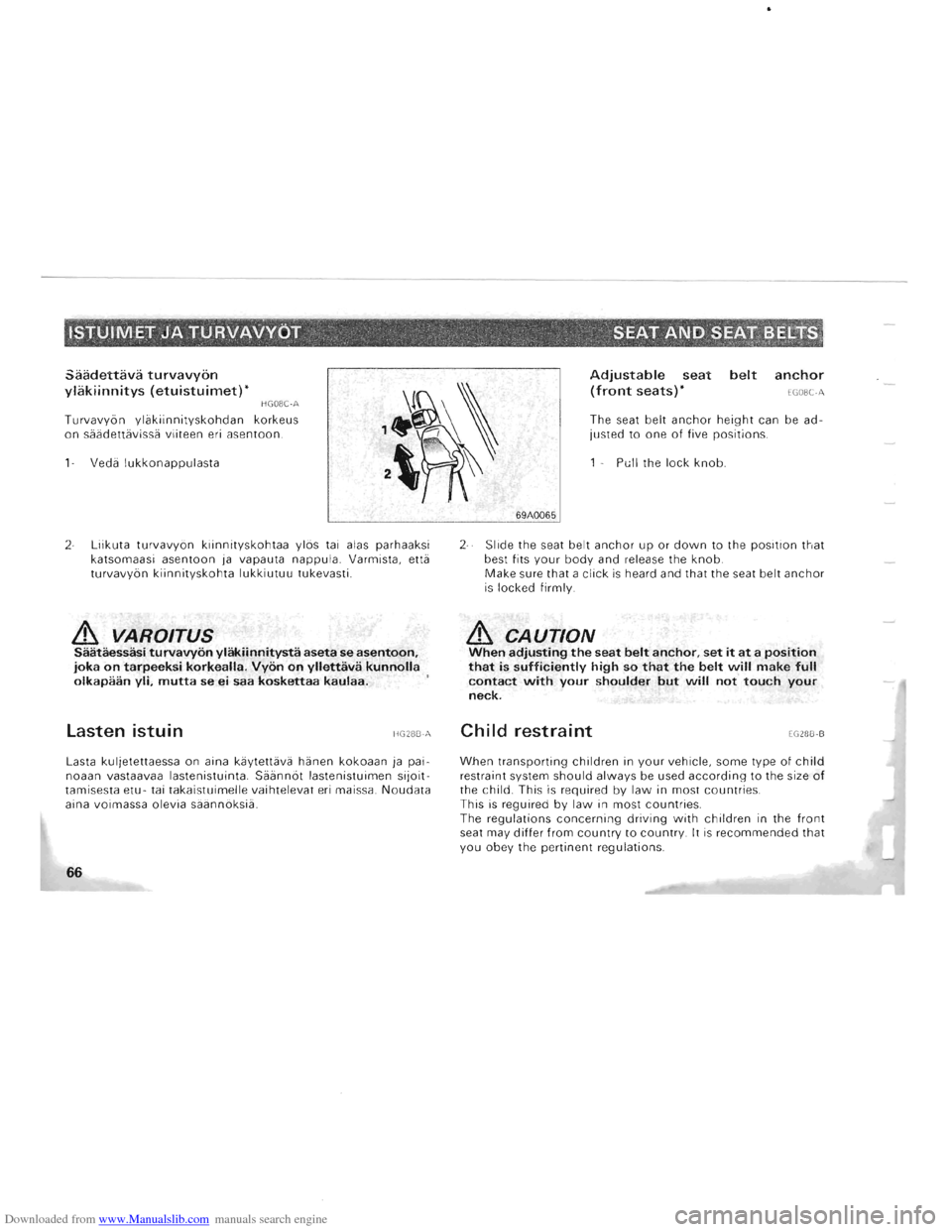
Downloaded from www.Manualslib.com manuals search engine Saadettava turvavyon
ylakiinnitys (etuistuimet)* HG08C·A
Turvavybn ylakiinnityskohdan korkeus
on saadettavissa viiteen eri asentoon.
1 - Veda
lukkonappulasta
2-Liikuta turvavybn kiinnityskohtaa ylbs tai alas parhaaksi
katsomaasi asentoon ja vapauta nappula. Varmista, etta
turvavybn kiinnityskohta lukkiutuu tukevasti.
& VAROITUS Saataessasi turvavyon ylakiinnitysta aseta se asentoon.
joka on tarpeeksi korkealla. Vyon on yllettava kunnolla
olkapaan yli. mutta se ei saa koskettaa kaulaa.
lasten istuin HG28B·A
Lasta kuljetettaessa on aina kaytettavii hanen kokoaan ja pai
noaan vastaavaa lastenistuinta . Saannbt lastenistuimen sijoittamisesta etu-tai takaistuimelle vaihtelevat eri maissa. Noudata
aina voimassa olevia saannbksia .
66
69A0065
Adjustable seat belt anchor
(front seats)* EG08C·A
The seat belt anchor height can be adjusted to one of five positions.
1 - Pull the
lock knob.
2-Slide the seat belt anchor up or down to the position that best fits your body and release the knob.
Make sure that a click is heard and that the seat belt anchor is locked firmly.
& CAUTION When adjusting the seat belt anchor. set it at a position that is sufficiently high so that the belt will make full contact with your shoulder but will not touch your neck.
Child restraint EG28B·B
W.hen transporting children in your vehicle, some type of child restraint system should always be used according to the size of the child. This is required by law in most countries.
This is reguired by law in most countries.
The regulations concerning driving with children in the front seat may differ from country to country. It is recommended that you obey the pertinent regulations.
Page 63 of 302
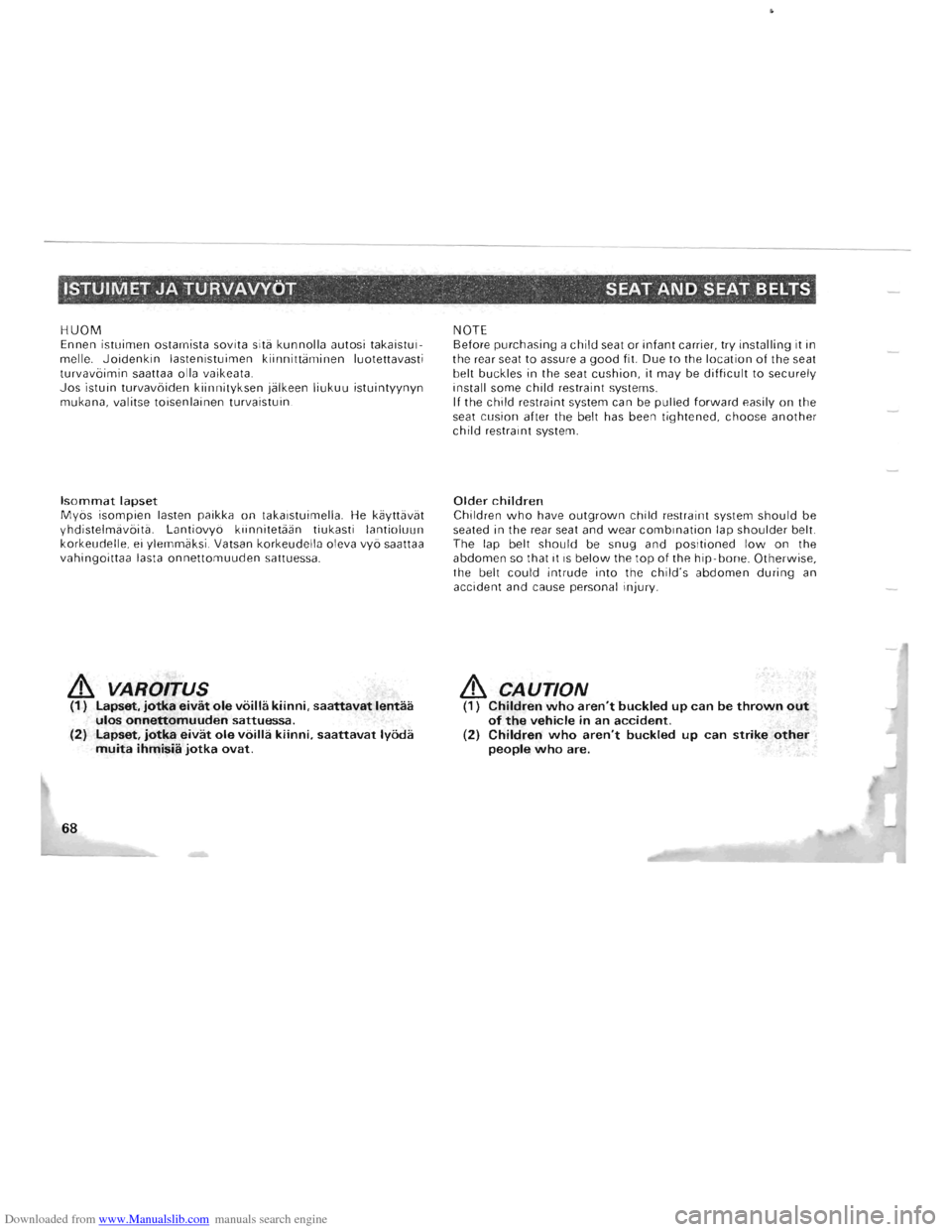
Downloaded from www.Manualslib.com manuals search engine ISTUIMET JA TURVAvYOT . SEAT AND SEAT BELTS
HUOM Ennen istuimen ostamista sovita sita kunnolla autosi takaistui
melle. Joidenkin lastenistuimen kiinnittaminen luotettavasti turvavoimin saattaa olla vaikeata. Jos istuin turvavoiden kiinnityksen jalkeen liukuu istuintyynyn mukana , valitse toisenlainen turvaistuin.
Isommat lapset Myos isompien lasten paikka on takaistuimella. He kayttavat
yhdistelmavoita. Lantiovyo kiinnitetaan tiukasti lantioluun korkeudelle, ei ylemmaksi. Vatsan korkeudella oleva vyo saattaa
vahingoittaa lasta onnettomuuden sattuessa.
& VAROITUS (1) lapset. jotka eivat ole voilla kiinni. saattavat lentaa
ulos onnettomuuden sattuessa. (2) lapset. jotka eivat ole voilla kiinni. saattavat lyOda muita ihmisia jotka ovat.
68
NOTE Before purchasing a child seat or infant carrier, try installing it in
the rear seat to assure a good fit Due to the location of the seat
belt buckles in the seat cushion, it may be difficult to securely
install some child restraint systems.
If the child restraint system can be pulled forward easily on the seat cusion after the belt has been tightened, choose another child restraint system.
Older children Children who have outgrown child restraint system should be
seated in the rear seat and wear combination lap shoulder belt The lap belt should be snug and positioned low on the abdomen so that it is below the top of the hip-bone . Otherwise,
the belt could intrude into the child's abdomen during an
accident and cause personal injury.
& CAUTION (1) Children who aren't buckled up can be thrown out of the vehicle in an accident,
(2) Children who aren't buckled up can strike other people who are.
Page 72 of 302

Downloaded from www.Manualslib.com manuals search engine MITTARISTO JA HALLINTALAITTEET -INSTRUMENTS & CONTROLS
Uimpomittari* HD10A·C
Liimpomittari niiyttiiii liimpotilan ulkona
ja sisiillii virtalukon ollessa asennossa "Ace tai "ON".
1 -
Liimpotila ajoneuvon ulkopuolella 2 -Liimpotila ajoneuvon sisiipuolella
3 -Sisii/ulkoliimpotilan niiyttovalitsi-men kytkin
Kytkintii painettaessa liimpomittari niiyttiiii vuoronperaiin sisa ja ulkoliimpotilan.
HUOM (1) Niikyvii ulkoliimpotila saattaa poiketa oikeasta johtuen ympiiristo-ja ajo-olosuhteista.
(2) Jos aJoneuvon sisiilla tai ulkopuolella oleva lampotila on
aile -30°C astetta tai yli 70'C astetta, niiytossa nakyy virhemerkintii (- E'C , E'C) .
Jos naytossa nakyy virhemerkintii vaikka liimpotila on -30'C
-70' C rajoissa, tarkastuta liimpomittari tai liimpotilan tunnistaja valtuutetulla MITSUBISHI-myyjalla.
78
Thermometer* EDlOA·D
The thermometer displays the tempera
tures inside and outside the vehicle when the ignition switch is at "ACe or "ON".
1 - Temperature outside the
vehicle 2- Temperature inside the vehic le
3 - Insid e/outside temperature display selector switch
Each time the switch is pressed the thermometer alt ernate ly
displays either the inside temperature or the outside tempera
ture.
NOTE
(1) Th e externa l temperature displayed may differ from the
actua l temperature on account of surrounding conditions, driving conditions, etc. (2) Temperatures inside or outside the vehicle that are below -30'C (- 22 °F) or over 70'C (158'F) will result in an error
message being displayed (- EOC or -EoF , EOC or E'F).
If
an error message is displayed even though the actua l tem
perature is within the range of -30°C ( -22 'F) to 70°C (158'F) contact an authorized MITSUBISHI dealer for inspection of the
thermometer's thermo sensor.
Page 74 of 302
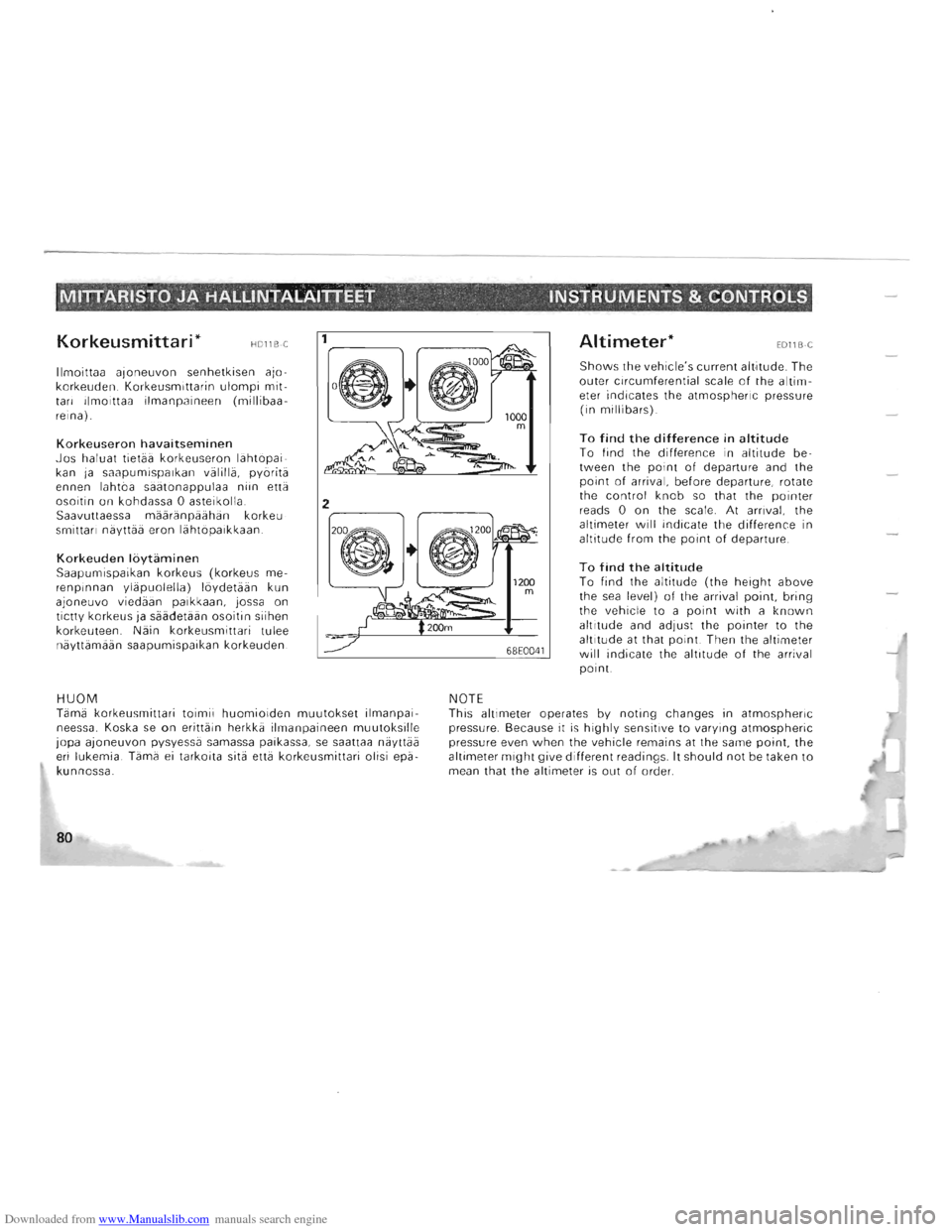
Downloaded from www.Manualslib.com manuals search engine MITTAR'ISTO JA HALLINTALAITTEET " INSTRUMENTS & CONTROLS , . ~. "
Korkeusm itta ri * HDllBC
IImoittaa ajoneuvon senhetkisen ajo
korkeuden . Korkeusmittarin ulompi mit
tari ilmoittaa ilmanpaineen (millibaa
reina).
Korkeuseron havaitseminen Jos haluat tietaa korkeuseron lahtopai
kan ja saapumispaikan valilla, pyorita
ennen lahtoa saatonappulaa niin etta
osoitin on kohdassa 0 asteikolla .
Saavuttaessa maaranpaahan kork eu
smittari naytt
aa eron lahtopaikkaan .
Korkeuden loytaminen Saapumispaikan korkeus (korkeus me
renpinnan ylapuolella) loydetaan kun
ajoneuvo viedaan paikkaan, jossa on
tictty korkeus ja saadetaan osoitin siihen
korkeuteen . Nain korkeusmittari tulee
nayttamaan saapumispaikan korkeuden.
HUOM
2 ;-------..
rama korkeusmittari toimii huomioiden muutokset ilmanpai
neessa . Koska se on erittain herkka ilmanpaineen muutoksille jopa ajoneuvon pysyessa samassa paikassa, se saattaa nayttaa eri lukemia . rama ei tarkoita sita etta korkeusmittari olisi epa
kunnossa .
80
NOTE
Altimeter* EDllB-C
Shows the vehicle's current altitude. The outer circumferential scale of the altim
eter indicates the atmospheric pressure
( in millibars) .
To find the difference in altitude To find the difference in altitude between the point of departure and the point of arrival. before departure , rotat e
the control knob so that the pointer reads 0 on the scale . At arrival. the
altimeter will indicate the difference in altitude from the point of departure.
To find the altitude To find the altitude (the height above
the sea level) of the arrival point. bring the vehicle to a point with a known altitude and adjust the pointer to the altitude at that point. Then the altimeter will indicate the altitude of the arrival
point.
This altimeter operates by
noting changes in atmospheric pressure. Because it is highly sensitive to varying atmospheric pressure even when the vehicle remains at the same point. the
altimeter might give different readings. It should not be taken to mean that the altimeter is out of order.
Page 102 of 302

Downloaded from www.Manualslib.com manuals search engine /faynnistys ja ajo
Sisaanajo5uosituksia ••••••••••••••••••\
••••••••••••••••••\
•••••••• 108 Polttoaineen kaytto (bensiinkayttoiset ajoneuvot) ••••••••••••••• •• 110 Katalysaattori ••••••••••••••••••\
••••••••••••••••••\
••••••••.••••• 112 Taloudellinen ajo ••••••••••••••••••\
••••••••••••••••• 0 •••••••••••• 113 Paravaunun hinaanline n ••••••••••••••••••\
••••••••••••••••••\
•••••• 114 Virtalukko •••••••••••••••••••••••••••••\
•••••••••••••••••••••••• 117 Ohjauspyodin lukitseminen ja lukon avaaminen •••••••••••••••••••• 118 Moottorin kaynnistaminen ••••••••••••••••••••••••••••••••••••••• 119 Dieselkayttoiset ajoneuvot • • • • •• •••••• • •• •• • •• •• ••••• ••• •• • • • ••• '21 Macttorin kierrosluvun saatonuppi' ••••••••••••••••••\
•••••••••••• 122 Kasivalintainen vaihteisto ••.••••••••••••••••\
••••••••••••••••••\
••• 123 Vaihtaminen ••••••••••••••••••\
•••••••••••••••••••••••••••••\
•••• 124 Automaattivaihteisto •••••••••••••••••••••••••\
••••••••••••••••••• 127 V alitsimen asennot ••••••••••••••••••\
••••••••••••••••••\
•••••••••• 128 Ylivaihteen saatokytkin ••••••••••••••••••\
••••••••••••••••••\
•••••• '29 Ohituskiihdytys ••••••••••••••••••\
••••••••••••••••••\
••••••••••••• 132 Pysahtyminen ••••••••••••••••••\
••••••••••••••••••\
•••••••••••••• 132 Pysak6iminen •••• • • • • • • • • • • • • . • • • • • • • • • • • • • • • • • • • • • • • • • • • • • • • •• 132 Saadettav3super·nelipyoraveto· • ••••••••••••••••••••••••••••••••• 133 Vaihtovivun asento ja 2 /4 -nelipyoravedon merkkivalo ••••••••••••••• 134 Jakovaihteiston vivun kflytto ••••••••••••••••••••••••••••••••••••\
• 136 Osa-aikainen nelipyoraveto ••••••••••••••••••\
••••••••••••••••••••• 139 Vaihtovivun asento ja 2/4 -pyoravedon ll1erkkivalo •••••••••••••••••• 140 Jakovaihteiston vivun kaytto (Ka sisaatoisilla na p alukoilla varustetut ajoneuvot) •••.••••.••.•••••••••\
•• , ••••••• , •. , ••••••••• 142 Vivun kayto (Automaattisilla napalukoilla varustetut ajoneuvot) •••.. 143 Napaluko t' ••••••••••••.••• •••••••• •••••••••••••••••••••••••• ' •• 144 Automaattiset napalukot ••••••••••••••••••••••••••••••••••••••••• 145 Takatasauspyoraston lukko ••••••••••••••••••\
••••••••••••••••••\
••• 148 Esimerkkeja takatasaupyoraston lukon tehokkaasta kaytosta •••••••• . 152 Esimerkkeja takatasauspyoniston luko n virheellisesta kayt6sta ••••••• 153 Oikea nelipy6 ravetoajo ••••••••••••••••••\
••••••••••••••••••\
•••••.• 155 Pysak6intijarru ••••••••••••••••••\
••••••••••••••••••\
••••••••••••• 160 Pysak6inti ••••••••••••••••••\
••••••••••••••••••\
••••••••••••••••• 161
Jarrutus •••••••••••••••••••••••••••\
••••••••••••••••••\
•••••••••• 162 lukkiutumisen estava jarrujarjes telma (A.B.S)' •••••••••••••••••••• 165 Ohjauspy6ran korkeude n saato .................................... 170 Ohjaustehostinjarjestelnla ••••••••••••••••••••••••••••••••••••••• 170 T austapeili •••••.••••• ,.......................................... 171
S ahkbtoimiset taustapeilit ••••••••••••••••••\
••••.•••••••••••••••• 171 Automaattinen nopeuden sa~lto ••••••••••••••••••••••••••••••••••\
172 3 muodo n saadettava iskunvainlennin' •••••••••••••••••••••••••••• 178
Starting and driving
Running-in recomnlendations ••••••••••••••••••\
••••••••••••••••••\
109 Fuel usage (Petrol powered vehicles) .............................. 110 Catalytic converter ••••••••••••••••••\
••••••••••••••••••\
•••••••••• 112 Econolnical driving ••••••••••••••••••\
•••••••••••••••••••••••••••• 11 3
Traile r towing •••••••••• •••••••••••••••••••••••••••\
••••••••••••• 114 Ignition switch •••••••• •••••••••••••••••••••••••••••••••••••••••• 117 How to loc k and unlock the s teering wheel •••.••••••••••••••••••• 118 Starting the engine ••••••••••••••••••••••••••••••••••••••••••••• 119 Diese l-powered vehicles •••••••• ' •••••••••••••••••••••••••••••••• 1 21 Engine rpm adjustment knob' ••••••••••••••••••\
••••••••••••••.•• 1 22 Manual transnlission ............................................. 123 Changing gears ••••••••••••••••••••••••••••••••••.•• •••••••••••• 124 Automatic transmission •••••••.••••••••••••••••••••••\
•••••••••••• 127 Selector positions ••••••••••••••••••••••••••••••••••••••••••••• •• 128 Overdrive control switch •••••••••••••• •• •••••.•••• •••••••••••••• 129 Passing acceleration •••••••••••••••••••••••••••••••••••\
•••••••••• 132 Waiting •••••••••••••••••••••••••••••••••••••••••••••••••••••••• 1 32
P arking ••••••••••••••••••••\
•••••••••••••••••••••••••••••••••••• 132 Super se lect 4WD' •••••••••••••••••••••••••••••••••••••••••••••• 133 Shift lever position and 2WO/4WO operation indication lamp ••••••• 135 Transfer shift lever operation •.••••.•••..••• ,...... .. ............ 136 Part tinlC 4WO' ••••• " •••••••••••••••••• ••••••••••••••••••••••• 139 Shift lever position and 2WO/4WO operation indication lamp ••••••• 141 Transfer shift lever operation (Vehicle s equipped with manual free-wheeling hubs) . ' •.•••.• ', ...••..• , ••••••••••••••••••\
••••••• 142 lever operation (vehic les equipped with automatiC free- w he eling hubs) " ••••• , ••.•••......•. " .•••• ' •••••••••••••••• 143 Free-wheeling hubs' •••••••••••..••• ' ••••••.••••••••••••\
••••••••• 144 Automatic free-w heeling hubs •••• , .••.• , •••••••••••••••• ••.••• •• 145 Rea r differential lock' ••••••••••••••••••••••••••••••• , ••••••• •••• 148 Examples of effective use of the re ar differential lock ••••••••••••••. 152 Examples of incorrect u se of the rear differential lock •••••••••••••• 153 Correct four-wheel drive operation ••••••••••••••••••\
•••••••••••• 155 Parking brake ••••••••••• ••••••••• ' ••••••••••••••••••\
•••••••••••• 160 Parking •••••••••••••••••••••••••••••••••••••••••••••••••••••••• 161 Braking ••••••••••••••••••\
••••••••••••••••••\
••••••••••••••••••\
•• 162 Anti-skid brake systenl (A.B .S .)' ••••••••••••••••••\
••••••••••••••• 165 Steering wheel height adjustmen t ................................. 170 Power steering sy ste m ' •...•..••.•••••••••.•.••••••••••••••••••• 170 Inside rear-view mirror •••••.•••••••••••••••••••••••••••••••••••• 171 Electric remote-controlled outside rear-view mirro rs' ••••••••••••••• 171 Auto-s peed (cruise) control' ••••••••••••••••••\
••••••••••••••••••\
• 172
3 -mode variable shock absorber' •••••••••••••••••••••.•••\
••••• ••• 178
Page 109 of 302

Downloaded from www.Manualslib.com manuals search engine KAYNNI,STYS JA AJO STARTING AND DRIVING
(5) Nopeur
M itii suurempi on nopeus, sitii enemmii n polttoainetta
moottori kiiyttiiii. Viilttiikiiii huippunopeuksilla ajamista,
sil lii
pienikin kaasun viihennys siiiistiiii huomattavan
miiiiriin polttoainetta.
(6) Pyorien ilmanpaine Tarkastakaa pyorien ilmanpaine siiiinnoilisin viiliajoin. Ma
tala paine lisiiii kitkaa ja polttoaineenkulutusta aiheuttaen niiin myos renkaiden ennenaikaista kulumista. (7) Kuormitus Alkiiii pitiiko tarpeettomia esineitii matkatavaratilassa. Li
siipaino lisiiii polttoaineenkulutusta huomattavasti, erityi
sesti kaupunkiajossa useine pysiiyksineen ja liikkelle liih
toineen.
Viilttiikiia myos tarpeetonta tavaroiden kuljetusta
kattotelineessii koska siitii aiheutuva ilmanvastus lisiiii
polttoaineenku lutusta. (8) Kylman moottorin kaynnistys Kylmiin moottorin kiiynnistys vaatii enemmiin polttoainetta, mutta myos lampimiin moottorin joutokiiynti kuluttaa turhaan polttoainetta. Liihtekiiii ajamaan melko pian moottorin kiiynnistyksen jiilkeen.
Paravaunun hinaaminen HC2 1AOFJ
Jos hinaatte periivaunua, tulee teidiin asennuttaa maanne la
kien vaatimukset tayttiiva hinauskoukku valtuutetussa MITSU
B I SH I huoltokorjaamossa . Hinausta koskevat siiiinnokset saat
tavat vaihdella maasta maahan, joten nou-dattakaa oman maanne siiiidoksiii. Hinatessanne perii-vaunua kiinnittiikiiii h~miota seuraaviin asioihin:
114
(5) Speed The higher the vehicle speed, the more fuel consumed. Avoid driving at full speed. Even a slight release of the
accelerator pedal will save a significant amount of fuel. (6) Tyre inflation pressure Check the tyre inflation pressure at regular intervals . Low tyre inflation pressures increase road resistance and fuel consumption. I n addition, low tyre pressures adversely
affect tyre wear and driving control. (7) Load Do not drive with unnecessary articles in the luggage compartment. Especially during city driving where frequent starting and stopping is necessary , the increased weight of the vehicle will greatly affect fuel consumption. Also avoid driving with unnecessary luggage, etc., on the roof; the
increased air resistance will cause more fuel consumption. (8) Cold engine starting Starting of a cold engine consumes more fuel. Unnecessary
fuel consumption is also caused by keeping a hot engine running. After the engine is started , begin driving soon.
Trailer towing FC21AOOa
In order to tow a trailer with your vehicle , have a trailer towing device that meets all pertinent regulations in your area mounted at an authorized MITSUBISHI dealer .
The regulations concerning the towing of a trailer may differ from country to country. It is recommended that you obey the
regulations in your area.
If you are going to tow a trailer , pay careful attention to the following points.
Page 131 of 302
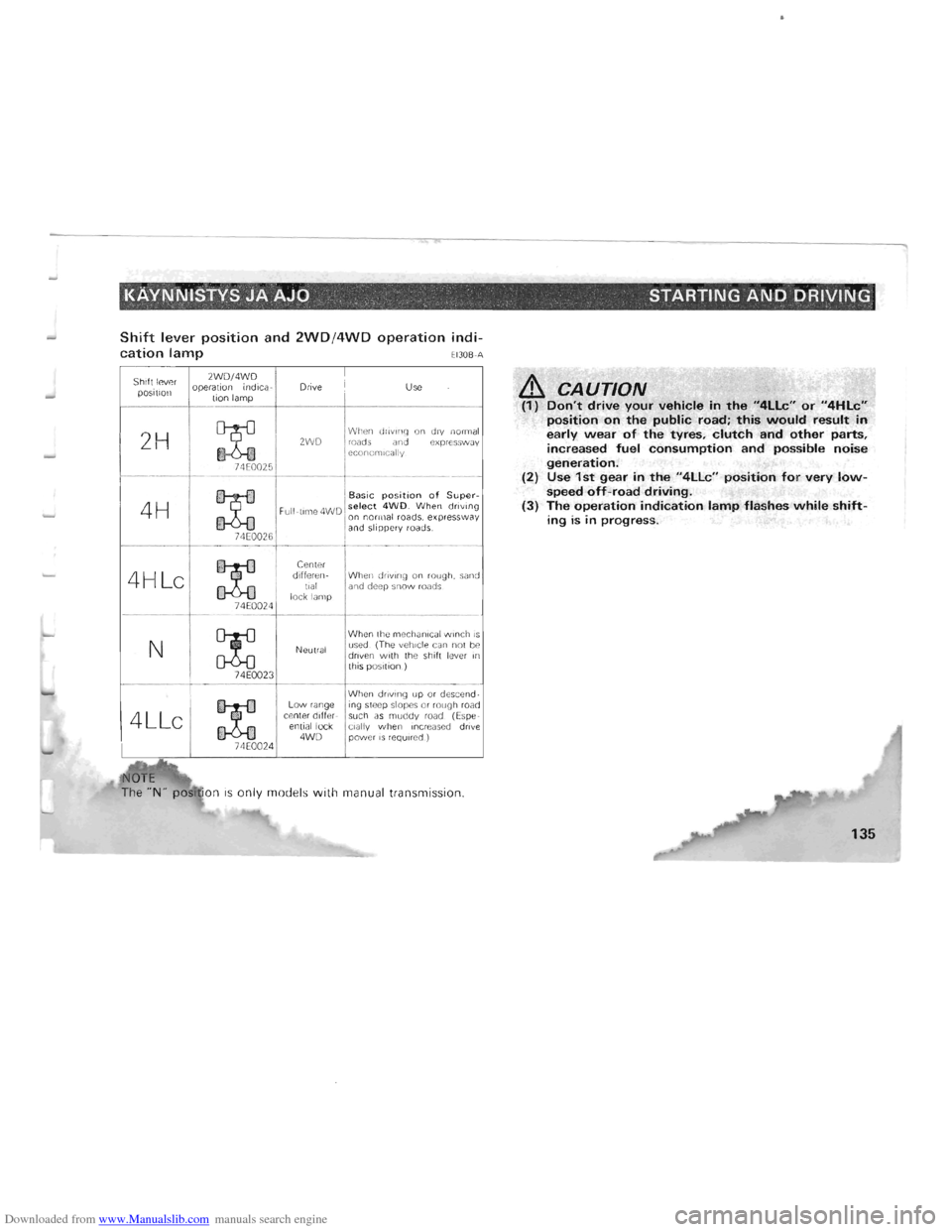
Downloaded from www.Manualslib.com manuals search engine KAYNNISTYS JA AJO . STARTING AND DRIVING
Shift lever position and 2WD/4WD operation indi
cation lamp El30B-A
Shift lever
posi tion
2 H
2WD/4WD operation indica
tion lamp
~ 74E0025 D
rive U
se
When driving on dry normal 2WD roads and expressway economically
---------1------1 ---------
4H
74E0026
4HLc
74E0024
N
74E0023
4LLc
74E0024
Basic position of Super
Fuli -tlme4WD select 4WD. W he n dri vin g
Io n n ormal roa ds, expressway an d s lippe ry roads.
Center
dlfferen- When dnvlng on rough. sand
tlal and deep
snow roads
lock lamp
Neu t
ral
Low range
cen te r differ
ential lock
4WD
When th e mechan ical winch IS used. (The vehicle can not be driven with the shift lever In this position)
When dnvlIlg up or descend ·
ing steep slopes or rough road
such as muddy road (Espe
Cially when Increased drive power IS required.)
~PO· I d I th I t on IS on y mo e S WI manua ransmlSSlOn .
·Lh CAUTION (1) Don't drive your vehicle in the "4llc" or "4Hlc" position on the public road; this would result in early wear of the tyres, clutch and other parts,
increased fuel consumption and possible noise
generation.
(2) Use 1st gear in the "4LLc" position for very lowspeed off-road driving. (3) The operation indication lamp flashes while shifting is in progress.
.,